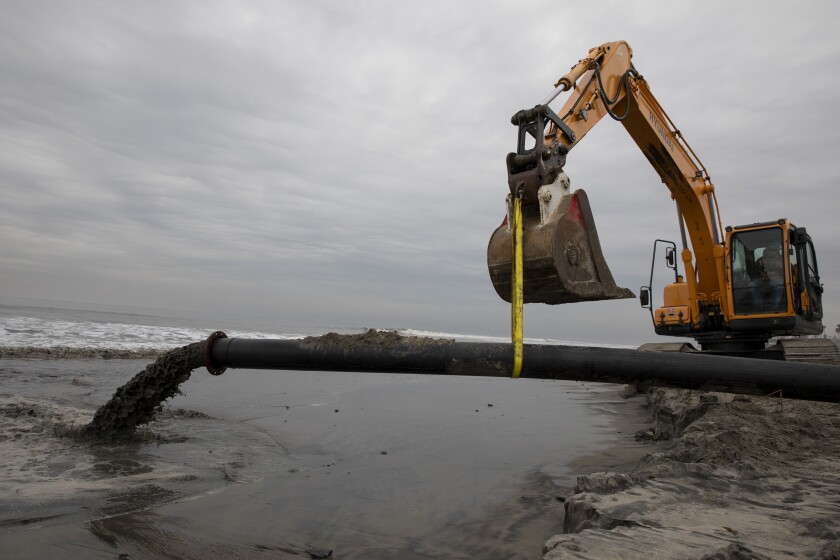
Posted on January 4, 2022
Project aims to improve the health of the lagoon and slow the natural erosion of the shoreline between Solana Beach and Encinitas
A floating, diesel-powered dredge sucked sand out of the San Elijo Lagoon on Thursday — pumping the wet, gray material through a long plastic pipe onto Cardiff State Beach.
Last week marked the start of the final leg of a $117-million restoration project, which nearby communities hope will also slow shoreline erosion. The vision was initially proposed in the 1990s but didn’t secure funding until 2017.
Specifically, the California Department of Transportation is creating a roughly 80-foot channel under Interstate 5 to allow more saltwater into the eastern parts of the wetlands. For decades, I-5 trapped freshwater runoff in the lagoon, encouraging the growth of invasive plants, such as cattails and bulrushes.
The restoration, which is expected to continue through the winter, has also deepened the lagoon with previous dredging and reintroduced native plants, such as cordgrass, which provides habitat for the federally endangered Ridgway’s rail.

The lagoon is already starting to show signs of healing, said Doug Gibson, executive director and principal scientist for the Nature Collective, formerly the San Elijo Lagoon Conservancy.
“We found our first octopus in the lagoon,” he said. “There are scallops all over the bottom. We have needlefish that we’ve never seen in the lagoon before.”
Caltrans and the San Diego Association of Governments partnered on the project with the Nature Collective, as well as the city of Encinitas. It’s part of the $6-billion North Coast Corridor Program, which includes the widening of I-5 and double-tracking the adjacent rail corridor between La Jolla and Oceanside.
Imagining the future of medicine and healthcare is one thing, evolving those ideas from science fiction to science reality is quite another. But that’s exactly what the Bristol Myers Squibb (BMS) Research & Development site in San Diego is…
This is a “once-in-a-lifetime” opportunity, said Jared Corbitt, resident engineer with Caltrans overseeing the endeavor. “This is one of the largest habitat restoration projects the state has done.
“The birds have just taken off,” he added. “There’s a lot of aquatic species that we’ve never seen before. We have sea lions in here.”
The dredging started last Tuesday and is expected to continue through early April. Crews will work Monday through Friday from 6 a.m. to 6 p.m. and, if needed, on Saturdays.

The effort follows similar beach nourishments in 2018. Officials said the lagoon’s dredge pit produces high-quality sand, not too fine or too coarse.
On Thursday, sand spewed from the plastic tube onto the beach near the Chart House restaurant on Highway 101. The blast of sand has been welcome news to nearby residents and businesses perched on the water.
“This particular part of the beach was getting very thin,” said Caltrans spokesperson Stephen Welborn, watching the dark-gray mass pour into the tide. “It was really lacking a lot of sand compared to the other parts of the beach.”
The shoreline will remain open throughout the process. Residents will likely hear noise and see nighttime lights in the lagoon. Fencing will be in place around equipment on the beach.
Over the next three months, Caltrans estimates it will dump more than 114,000 tons of wet sand onto Cardiff, roughly enough to fill 19 Olympic-sized swimming pools.





